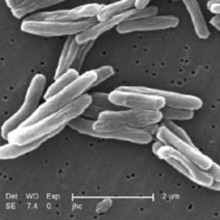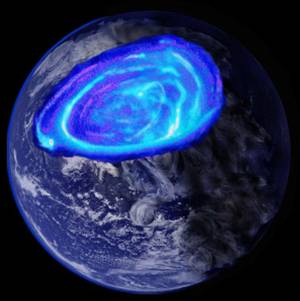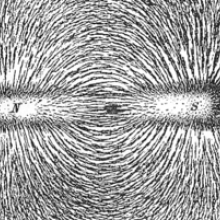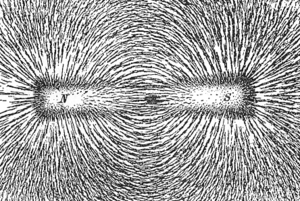On this week's NewsFlash, the gene combination that's perfect for tuberculosis, the methane time-bomb ticking off the Siberian coast, the first human writing and how doctors are knocking migraines on the head with a magnet!
In this episode

00:11 - Gene combo causes susceptibility to tuberculosis
Gene combo causes susceptibility to tuberculosis
This week it looks like researchers have discovered a key reason why some people are susceptible to TB (tuberculosis) and others aren't. Publishing in the journal Cell, Lalita Ramakrishnan and colleagues from the University of Washington think that it's the levels of an enzyme called LTA4H which give some people better immunity.
And it's not those with more of the enzyme who are the winners, nor people with the  lowest levels of LTA4H. Similar to Goldilocks and the three bears, it's actually those individuals who have a middling or 'just right' amount of the immune enzyme who have TB resistance.
lowest levels of LTA4H. Similar to Goldilocks and the three bears, it's actually those individuals who have a middling or 'just right' amount of the immune enzyme who have TB resistance.
People who are heterozygous or have two different versions of the gene which makes LTA4H have this middling amount of the enzyme. The researchers tested this in a controlled environment by looking at zebrafish which had been selected to produce different levels of the enzyme. It soon became apparent that LTA4H was playing some role in their immunity. Ramakrishnan then compared her findings with human geneticists from Washington, Vietnam and Nepal to see if they were the same. And it emerged that it was this heterozygosity in people which produced the ideal levels of the enzyme.
What's interesting about this is that, for a long time it's been known that people with a nasty case of TB may improve if you give them a dose of anti-inflammatories. It may be that these people are producing too much of LTA4H and by giving them anti-inflammatories you reduce the effect of the enzyme to a medium level; this makes life difficult for the TB bacteria - making the patient feel better.
And it's an important finding because there are now many strains of TB which are drug-resistant. If you can tinker with the human immune system instead you might come up with a better solution to the problem. Plus there's the added bonus that LTA4H also confers immunity to other mycobacterial infections like leprosy.

02:35 - East Siberian Methane Timebomb
East Siberian Methane Timebomb
Millions of tonnes of methane locked up beneath the shoreline of Siberia are becoming unstable and escaping into the air, threatening to accelerate climate change...
The findings, which are published in the journal Science by University of Alaska Fairbanks researcher Natalia Shakova and her colleagues, suggest that the East Siberian Arctic Shelf, which covers an area of about 2 million square kilometres, is releasing more methane than the rest of the world's oceans put together.
But unlike other methane sources, where the gas is produced by bacteria breaking down organic matter in sediments, the Siberian methane deposits are pre-made and sequestered under the sea as so called hydrates - gas-filled watery cages.
This means that any event that destabilises the deposits can cause them to release their stored methane.
"We think that's what's happening here," says Shakova. "Warming temperatures, and the ingress of the ocean as sea-level rises, are causing the methane release to accelerate, possibly precipitiously."
The team made the discovery by mounting a series of expeditions to collect water and air samples from the Siberian coastline. What they found were very high concentrations of the gas in the seawater, arguing for an undersea source.
The concern is that, with global warming, more fresh water entering the area from melting permafrost will cause local sea temperatures to rise, further destabilising the methane deposits and causing the seafloor to surrender its stored gas in a series of convulsive oceanic belches.
This would dramatically accelerate the rate of global warming because methane is at least 30 fold more potent as a greenhouse gas than the equivalent amount of CO2.
"The release to the atmosphere of only one percent of the methane assumed to be stored might alter the current atmospheric burden of methane up to 3 to 4 times," says Shakova. "The climate consequences would be hard to predict..."

04:48 - The Earliest Symbolic Scratchings
The Earliest Symbolic Scratchings
This week archaeologists have described the discovery of some of the earliest evidence for advanced human thought. Publishing in the journal PNAS, Pierre-Jean Texier and colleagues have analysed nearly 300 bits of carved ostrich shell from a site in South Africa.
These shell fragments are thought to be about 65,000 years old and were found at the site of Diepkloof rock shelter where there are layers and layers of Middle Stone Age archaeology. These eggshell fragments have a fairly common motif on them which involves the scoring of two parallel lines and some cross-hatching linking them. So they  look a bit like a simplified picket fence drawing.
look a bit like a simplified picket fence drawing.
Doesn't sound like a very hard graphic to achieve - could it just be someone doodling? Well the authors of the study think not because the design was prevalent on so many pieces. Also when they tried to copy the design by using knapped flints and a new ostrich egg they found it was really tough to score any sorts of lines on the surface. So this work does seem to be very intentional.
It's not the first evidence of artwork per se as there have been shell bead discoveries, also from Africa of about 75,000 years old and some more examples farther away this time, in Isreal, which date back 90,000 years. But these ostrich shells are one of the earliest examples of graphic design.
It's important because it demonstrates what's known as symbolic thought; the idea that some kind of decoration or image can carry a meaning that is understood by other members of your society. So for example, if you have decoration on your ostrich egg water vessel - it might imply you belong to a particular group of people, maybe you're making yourself more attractive by doing it, maybe it was something only the adults or only the women did. We may never know what these graphics mean but they do point to some sort of advance in human thought about 65,000 years ago.

07:24 - Researchers wind back Earth's Magnetic Clock
Researchers wind back Earth's Magnetic Clock
Scientists have found evidence for a magnetic field around the Earth going back at least 3.5 billion years, 250 million years earlier than previously thought.
The results also reveal that, at 50-70% of  present-day levels, the field would have been much weaker than it is now, meaning that the early Earth would have taken a harsh battering from the solar wind, stripping away water and light elements like hydrogen.
present-day levels, the field would have been much weaker than it is now, meaning that the early Earth would have taken a harsh battering from the solar wind, stripping away water and light elements like hydrogen.
The discovery, which is published in Science, was made by University of Rochester researcher John Tarduno and his colleagues. He and his team scoured South Africa for ancient quartz rock samples dating back more than 3.5 billion years. These were tested using a device called a SQUID (superconducting quantum interface device) magnetometer, which can read the magnetic field imprinted into rocks when they first form and being to cool.
In this way the Earth's magnetic field can be reconstructed going back billions of years. Previously, similar approaches had yielded evidence for a magnetic field around the planet from about 3.2 billion years ago but the new results push this date back to 3.5 billion years, indicating that the "geodynamo" - the pool of circulating iron at the Earth's core - was active by this time.
Critically, the results also show that the magnetic field was only half as strong as it is today. This, coupled with the fact that the young Sun was ejecting a solar wind far fiercer than it is today, would have meant that the planet had a harder time fending off the onslaught, which would have robbed the Earth of large amounts of water and would probably have meant the northern lights would have been visible from London rather than northern Norway!

10:08 - Magnets Mitigate Migraine
Magnets Mitigate Migraine
Dr Richard Lipton, Albert Einstein College of Medicine
Chris - Also in the news this week, researchers have shown that you can knock migraines on the head with a magnet. Dr. Richard Lipton is a neurologist at the Albert Einstein College of Medicine. He's based in New York and he is with us now. Hello, Richard.
Richard - Hi, there.
Chris - Welcome to the Naked Scientists. You've worked on migraines but many people may not understand exactly what a migraine is. So could you first of all tell us what a migraine really is, medically speaking?
Richard - Sure. So migraine is a specific headache disorder that's characterised by pain that's usually one-sided, usually throbbing, often associated with a visual display called an aura, but always associated with something other than just pain, sometimes aura, sometimes nausea, sometimes sensitivity to light or sound.
 Chris - And what do we think is going on in the brain to trigger these, initially, visual effects and then this throbbing pulsing headache that makes people do other things like retire into a dark room and sometimes unfortunately experience nausea?
Chris - And what do we think is going on in the brain to trigger these, initially, visual effects and then this throbbing pulsing headache that makes people do other things like retire into a dark room and sometimes unfortunately experience nausea?
Richard - Well for migraine with aura, which was what my study was about, there's a lot of evidence that what's going on in the brain is an event called cortical spreading depression. And in cortical spreading depression, which you can also produce very easily in experimental animals, you have a wave of excitation followed by a wave of inhibition marches slowly forward over the surface of the brain. As it marches, if it's in visual cortex, it produces spots of light, the zigzag lines, and then the inhibition produces a greying out of vision which is sometimes called the scotoma.
Chris - And then people get the pain, but why do they experience pain?
Richard - The link between aura and pain probably has to do with the fact that there are pain sensitive fibres in the membranes that surround the brain, referred to as the meninges, and the aura itself directly activates these pain sensitive fibres in the brain which are parts of a nerve called the trigeminal nerve and that is likely how aura initiates pain in migraine.
Chris - So in your study, you were asking, can a pulse of magnetism alter the outcome of someone seeing initially these auras. Does it prevent them going on to get a headache?
Richard - Well, the method we used is called transcranial magnetic stimulation. It's a method that's been around for 30 years. The idea is that if you apply a powerful magnet to the surface of the skull, the magnetic field penetrates through the skull into the brain and induces a small amount of current flow and depending on where you do it and when you do it, that can have either diagnostic or therapeutic applications.
Chris - So how many people did you enrol in your study and what were the outcomes?
Richard - So here, the idea was to use a magnetic pulse to induce a current during the aura of migraine with the idea that if you induce the current flow, you would disrupt that march of electrical activity and possibly prevent or dramatically reduce pain. So we ended up randomizing about 200 people, 160 of whom we ended up treating either with the real magnetic device or with a sham device that vibrated and clicked, but did not deliver a magnetic field. And we found that of the people who got the real device, 40% were pain-free 2 hours later and remained pain-free at 24 and 48 hours, so most of them. Whereas only 20% did that well when they were treated with the sham device and that's a result comparable to what you see with the best as available medical therapy.
Chris - Speaking of which, I've got an email here from Seraphina Anderson who says, "Why don't normal pain killers like paracetamol or ibuprofen work when you get a migraine?"
Richard - Well sometimes they do and you know, and like every condition, there's a broad spectrum of severity. So, ibuprofen and paracetamol may work if you treat the migraine very early. If you wait and wonder if you need to treat, oral medications become less effective because migraine also affects the gut and you may not absorb the medication as well. For people who don't do well with over-the-counter medications, there's certainly a wide range of prescription drug options that are very effective. So I'm certainly not saying this is the only way to treat migraine.
Chris - Given how common it is, very large numbers of people suffer with migraines, is your method safe, to your knowledge, and therefore, what's the next step? Will we be seeing magnetic stimulators on the shelves of pharmacy shops so people can go and get one if they regularly suffer migraines?
Richard - My hope is that the answer is yes. So in the UK, 18% of women, 6% of men have migraine so it's an extraordinarily common disorder in the UK, in the US and Western Europe or really around the world. Yes, the hope is that this will receive regulatory approval as a medical device and that it will become available to people who want to use it. There is a portable device - For most of its 30-year history, TMS was given with a large 70-pound device that cost perhaps $25 to $30,000 that was kept in doctor's offices and used by medical personnel. We studied a portable device that weighs about 3 pounds. It's about the size of a hair dryer and the intention is that people will take the device home and when they get a headache, they'll have an alternative to reaching for either an over-the-counter or prescription medication.
Chris - Let's hope so. Thank you very much. Richard Lipton, who's at Albert Einstein College of Medicine and that research, if you want to read up a little bit more about it, it's in the April edition of the Lancet Neurology.
Related Content
- Previous How is money made?
- Next The Science of Solar: Photovoltaics










Comments
Add a comment